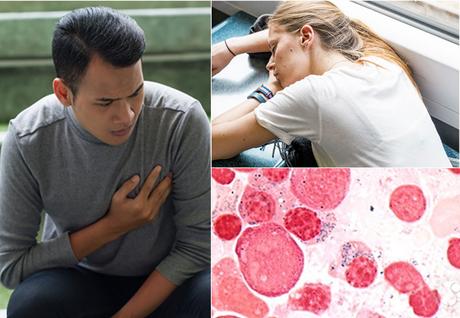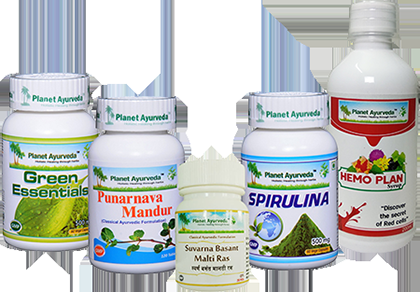Abstract
In this article our main topic of discussion will be a very common blood disorder known as sideroblastic anemia. It is a type of anemia and has a great prevalence rate. Ayurveda deals with such ailment by doing detailed study of individuals prakriti (nature), and then we uses medication according to that by following basic principles of ayurveda tridosha theory (three principle energies of our body- vata, pitta and kapha) and panchamahabhuta theory (five basic elements of life- akash (sky), vayu (air), agni (fire), jal (water) and prithvi (mother earth). So let's start discussing this in more detail.
Introduction
Sideroblastic anemia is a type of anemia in which bone marrow starts producing ringed sideroblasts (they are nucleated erythroblasts that are precursors to mature red blood cells) instead of normal red blood cells (erythrocytes). In a normal healthy person these sideroblasts are present in bone marrow and enter blood circulation after maturing into red blood cells. So this process of maturing and entering into the main blood stream of sideroblast got affected in sideroblastic anemia.
As per ayurveda we can correlate this with "pandu roga". In this pitta dosha gets aggravated in the body due to those body tissues starting undergoing inflammatory reactions that make the body weak and lethargic. This leads to deterioration of varna (colour), bala (strength), sneha (protective fat layer of the body) and ojas (immunity power).

Etiological Factors
These are the main causes (nidan as per ayurveda) that results in formation of an ailment.
In sideroblastic anemia the common causes are as follow
- Hereditary involvement- in most of the cases congenital sideroblastic anemia occurs due to presence of x-linked sideroblastic anemia or autosomal recessive sideroblastic anemia.
Due to the presence of following genetic syndromes
- Ataxia
- Myopathy
- Pancreatic insufficiency
- Excessive alcohol consumption
- Deficiency of vitamin B6 and copper
- Lead poisoning.
- Disorders of bone marrow.
- Malnutrition
According to Ayurveda
1. Ahaaraj nidan (dietary causes)
- Intake of amla (sour), lavan (salty), kshaar (alkali) and ushna (hot) food items.
- Consumption of virudh and asatmya bhojan
- Use of tikshna and vidagdha food substances.
- Pramitashan
2. Vihaaraj nidan (lifestyle related causes)
- Ati vyayam (over use of physical activities)
- Divashayan (who sleeps during day time)
- Ati maithun (excessive use of sexual activities)
- Veg dharna (suppression of natural urges)
Prodromal Symptoms (Purvarupa)
These are the common complaints or early signs/symptoms that indicate onset of a disease.
Our acharya had clearly mentioned this in our ancient classical text and are as follows.
- Palpitation
- Dryness of skin
- No sweating
- Fatigue
- Excessive salivation
- Malaise
- Desire to eat clay/ mud
- Swelling around the eyes
- Yellowness of urine and stool
- Indigestion.
Clinical Features
It includes the signs and symptoms. Asymptom means the general complaints along with patients present in front of the physician. It means what a physician notices himself by observing the patient's condition.
- Paleness in the skin.
- Fatigue and malaise
- Dizziness
- Indigestion
- Anorexia (loss of appetite)
- Vertigo
- Cramps in legs
According to Ayurveda
- Pallor of skin
- Scanty blood
- Fat deficiency
- Loss of glow
- Tinnitus
- Generalized body weakness
- Anorexia (loss of appetite)
- Fatigue
- Vertigo
- Fever
- Exertional dyspnoea
- Fall of hairs
- Hate cold environment
- Excessive sleep
- Speech becomes feeble in nature.
- Cramps in calf region
Types of sideroblastic anemia
1. Type 1 sideroblasts: Presence of less than 5 siderotic granules in the cytoplasm of the cell.
2. Type 2 sideroblasts: There will be a presence of 5 or more siderotic granules in this type.
3. Type 3/ ring sideroblasts: Presence of 5 or more granules in a perinuclear position that covers the one third portion of nuclear circumference. This type is included in sideroblastic anemia whereas the previous first two types are included in non sideroblastic anemia.
Complications
It means certain conditions that might occur in future due to presence of sideroblastic anemia for a long term basis.
- Anorexia
- Excessive thirst
- Vomiting
- Headache
- Indigestion
- Emaciation
- Fainting
- Malaise
- Cardiac pain
- Exertional dyspnoea
- Diarrhea
- Cough
- Burning sensation
- Hoarseness of voice
Diagnosis
Detailed physical examination of the patient by using inspection, palpation, percussion and auscultation techniques.
Laboratory findings: Complete blood count test
- It shows a high level of serum iron and increased ferritin levels.
- Decreased total iron binding capacity.
- On blood smear- Presence of ringed shaped sideroblasts are seen.
According to Ayurveda - The two most preferred diagnostic procedures used by a physician are as follow
Trividh pariksha (Group of 3 diagnostic procedures)
- Darshan- Diagnosis is made by visual examination of the symptoms.
- Sparshan-Physician uses tactile examination to evaluate whether skin is cold/hot
- Prashan- Physicians ask direct questions from the patient, to evaluate the root cause of the disease i.e. history taking.
Asthavidh pariksha (set of 8 examination procedure)
- Nadi pariksha- By palpating the pulse rate of the patient.
- Mutra pariksha- By examining the urine of the patient.
- Mal pariksha- By stool examination.
- Jivha pariksha- By examining the tongue whether coated or not.
- Shabad pariksha- By listening to the natural sounds within the body like intestinal sound (peristalsis) sounds of moving body fluids.
- Sparsh pariksha- By observing the patient skin texture whether it is cool, wet or dry.
- Drik pariksha- When a physician inspects patient symptoms through his/her eyes.
- Akriti pariksha- When a physician evaluates the general appearance of a patient whether he/she looks dull, lethargic or fatigued etc.
Management
According to Ayurveda the main line of treatment is as follow
- Nidan parivarjan chikitsa (avoiding the root cause of disease) - This treatment modality had been given utmost importance in our ancient text. As according to ayurveda
- Sanshodhan chikitsa (detoxification procedure)- As per charaka chikitsa 16/40-
(i). Abhiyantra sanehan - Smoothing the internal dosha's of our body by using herbally medicated ghrita/oil.
Example
- Panchagavya ghrita
- Mahatikta ghrita
- Draksha ghrita
Dosage: 10-20 ml with warm water after meals.
(ii). Tikshan sanshodhan - In this tikshna herbs are used for vaman and virechna karma
- Vaman (emesis) - emetic medicines are given to the patient to take out the vitiated dosha of the body.
- Virechana (purgation) is the best technique to release out the pitta dosha from the body by anal route. We can use- gomutra and haritaki churna for this.
(iii). Basti- In this liquid form of medicine is put inside the body via anal route with the help of specially made basti yantra (instrument). In sideroblastic anemia we will use rakta basti specifically.
3. Sanshaman chikitsa (Oral medications) - In this use of medication by oral route is done.
1. Rasa/bhasma/loha/mandur
Dosage: 125-250 mg with honey or water after meals.
2. Vati
Dosage: 250-500 mg with honey or water after meals.
3. Asava
Dosage: 20-40 ml with equal amount of water after meals.
4. Avaleha
Dosage: 10-20 gm with water after meal.
List of Planet Ayurveda Herbal Formulations


Planet ayurveda has been serving people worldwide for the past 20 years with their holistic approach to healing. Their herbal products are made under the guidance of ayurveda experts and are very effective in maintaining a healthy and sound body as they are completely pure and organic in nature. They offer various herbal formulations that works really well in condition like sideroblastic anemia, some of them are as follow:
- Green Essentials
- Spirulina capsules
- Punarnava mandur
- HemoPlan syrup
- Suvarna Basant malti ras
Products Description
1. Green essentials
This herbal formulation contains potent blend of medicinal herbs such as
- grape seed (Vitis vinifera)
- wheat grass (Triticulum aestivum)
- spirulina (Spirulina platensis)
- green tea (Camellia sinensis)
- amla (Embllica officinalis)
All the herbs present in this herbal formulation have great immunity enhancing properties. It also contains a good amount of antioxidants and other necessary nutrients that will assist very profoundly in sideroblastic anemia.
Dosage: 1 capsule twice daily with plain water after meals.
2. Spirulina capsules
This capsule contains a pure form of spirulina ( Spirulina platensis). It is a rich source of various healthy micro and macro nutrients. It is known for its immunity enhancing property. It also has anti cancerous properties so helps in maintaining overall strength and stamina of patients of sideroblastic anemia.
Dosage: 1 cap twice daily with plain water after meal.
3. Punarnava mandur
This herbal formulation is imbued with plenty of therapeutic actions as it contains punarnava ( Boerhaavia diffusa) which is very effective in increasing the digestive power of the body. Other herbs present in the formulations such as
- pipali (Piper longum)
- sunthi (Zingiber officinale)
- amalaki (Emblica officinale)
- haridra (Curcuma longa) etc
Contain anti-inflammatory antifungal properties so it works really well in patients suffering from sideroblastic anemia.
Dosage: 2 tabs twice daily with plain water after meal.
4. Hemoplan syp
This herbal syrup is potent blend of various medicinal herbs such as
- manjishtha (Rubia cordifolia)
- shatavari (Asparagus racemosus)
- gorakhmundi (Sphaeranthus indicus)
- ashwagandha (Withania somnifera)
- draksha (Vitis vinifera)
- sariva (Hemidesmus indicus).
It has great blood enhancing properties that will help in increasing hemoglobin concentration in the blood. It also helps in providing strength and stamina to patients suffering from sideroblastic anemia.
Dosage: 2 tsf twice daily after meal.
5. Suvarna Basant malti ras
This herbomineral formulation contains properties like anti-inflammatory (reduce inflammation). It helps in boosting up the immunity of our body by balancing tridosha. It also possesses "rasayan" property that rejuvenates the body channels and helps in lengthening the lifespan of sideroblastic anemia patients. It contains marich ( Piper nigrum), kharpara bhasma (calamine in an incinerated form), shuddha hingula (cinnabar in a purified form), swarna bhasma (gold in an incinerated form) etc.
Dosage: 1 tab twice daily with plain water after meal.
Contact my assistant to provide you the costing / ordering and delivery information at - [email protected] or call at +91-172-5214030 Or Check Website - www.PlanetAyurveda.com
Conclusion
We can now conclude that in an ailment like sideroblastic anemia ayurvedic herbs works very efficiently. In sideroblastic anemia the main culprit is the elevated Pitta dosha so our main concern is to deal with it intrinsically. For Ayurvedic treatment, you can consider choosing Planet Ayurveda as we have been serving mankind with our holistic approach of healing. You can directly visit us at our clinic at Mohali, Punjab or can send your queries on our official email id- [email protected]

